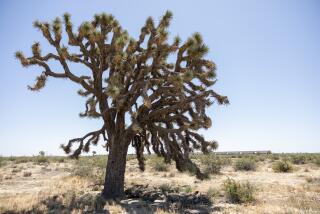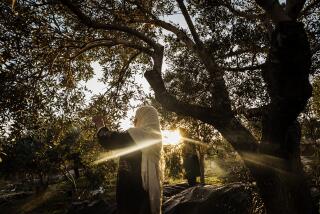For Israeli Pioneers, Negev Desert Holds Promise of a Fruitful Future : Mideast: Innovative agriculture uses brackish water to raise crops such as shrimp, algae and edible cactus for a limited--but lucrative--market.
- Share via
SDE BOKER, Israel — Think of Israel’s parched, moonscape Negev Desert, sweltering this summer under a historically severe drought, and the last thing you’d imagine is shrimp.
Not only are the crinkly crustaceans a very un-kosher dish in the Jewish state, they are also an aquatic creature more at home, presumably, in seas than in sand.
Yet the raising of shrimp--and lobster, eel and a variety of fish--is among the experiments in innovative agriculture being conducted by today’s pioneers of the Negev.
The dream of Israel’s founders was, in the 1949 words of first Prime Minister David Ben Gurion, to make the desert bloom. That never quite happened here in the Negev, a vast, arid plateau that makes up 60% of Israeli territory but is home to only 7% of its population.
Today, the worst drought in 60 years is again forcing Israel to reexamine use of already scarce water. Instead of creating a desert in bloom, Israeli scientists and farmers are turning to alternative agriculture that makes use of underground brackish water and pursues limited but lucrative boutique markets over mass commerce.
And so they grow shrimp, algae and edible cactus instead of traditional crops like water-intensive citrus and cotton. The exotic products remain a fraction of Israel’s agricultural output, but they are seen as key to the desert’s prosperity.
Available Land Is Dwindling
The so-called new agriculture is one component in a broader scheme to expand development of the Negev, an idea that is becoming increasingly critical as Israel prepares to relinquish more of the West Bank--and possibly the fertile Golan Heights--in the pursuit of peace deals with the Palestinians, Syria and Lebanon. The amount of available land in this already tiny country is dwindling.
Living in the Negev Desert, where temperatures average about 97.5 degrees in August and the rainfall doesn’t, is still the purview of a hardy few.
But advocates of the desert life say a more efficient use of water to grow high-return crops can provide both income and drawing power for those who are willing to give it a try. The advantages, they say, are cheap land, consistent weather (that’s hot, and hot), lots of sunlight and a good supply of brackish, or slightly salty, water.
The Negev--the land where Abraham once wandered and watered his sheep at ancient wells--sits on a huge prehistoric thermal aquifer, a veritable ocean of saline water about 700 yards below the surface.
“The future of Israel is here in the south,” said biologist Avigad Vonshak, who heads a desert research program at Ben Gurion University of the Negev. “Unless you believe we have to conquer back the West Bank and Lebanon, there’s no other choice.”
Vonshak is doing his part in the rambling, squat buildings of the university’s Blaustein Institute for Desert Research in Sde Boker. He specializes in a green, slimy, fuzzy gold mine: algae.
Selling for $91 to $1,136 a pound, algae, which are rich in vitamin A, can be grown relatively easily with marginal water, Vonshak says. Algae uses span the market, from nutritional supplements to the pigmentations that color eye shadow.
“Politicians are allowed to dream of conquering the desert,” Vonshak said in his cluttered office, where signs saying “Algae Make My Day” hang on the wall. “The scientist knows that you will never conquer the desert. But you can come to live with it on certain terms.”
And growing algae in the desert seems about as paradoxical to Vonshak as, say, raising fish in the desert.
A few miles from Vonshak’s algae vats in Sde Boker, in the middle of a deserted khaki-colored wasteland, Itamar Keider is tending 15 fishponds the size of two football fields--stocked with tons of tropical tilapia, also known as St. Peter’s fish, as well as mullet and carp.
The brackish water pumped from beneath the desert surface is naturally hot, nearly 100 degrees, which apparently encourages high-density breeding. Once the water circulates through the fishponds, it is recycled--laden now with nitrates and ammonia--to irrigate nearby olive groves that thrive on the chemicals.
Keider, who moved from a kibbutz in the north to farm fish in the Negev, says the conditions are a big plus. “We can raise fish all year, and, with the heat, the breeding is intense,” he said. “It’s completely different from growing fish in the north.”
By far the most unusual desert crop these days comes from the shrimp farm at the Mashabei Sade kibbutz. The pilot project is an attempt to discover other kinds of tropical fish that might thrive in thermal waters and bring in revenue for the struggling collective.
Sensitive to potential religious objections over contaminating the Land of Israel with un-kosher creatures, the managers of the project have lined the shrimp pools with a thick plastic sheeting so that, technically, the kibbutznik crustaceans do not touch Israeli soil.
For Mashabei Sade, the cultivation of shrimp is also part of an effort to diversify the kibbutz economy. Israel’s kibbutzim are faced with mounting financial troubles and a declining population. Increasingly they are rejecting agriculture and taking on ventures that range from the pumping of gasoline to the operation of inns, restaurants and wedding banquet halls.
“We thought the profits we’d get [with shrimp] are higher than with tilapia” or other traditional fish, said Amit Ziv, a kibbutznik who helps manage the shrimp farm. The target yield is about 100 tons of shrimp a year, he said.
Most of the shrimp is going to the restaurants and fish markets of Tel Aviv and Israel’s Red Sea resort city of Eilat, Ziv said as he showed a visitor one of the shrimp, a milky-white, translucent specimen measuring about 5 inches long.
Born and raised on the kibbutz, Ziv, 32, speaks passionately about the need to preserve life on the kibbutz--where young people are leaving in droves--and in the Negev.
“Once you’ve seen a sunset on the Negev, you’ll see why people stay in the Negev,” he said.
Others See Future in High-Profit Casinos
It may be a minority opinion. The advocates of new agriculture are fighting against forces that would give up altogether on trying to cultivate a crop in the desert. These forces, instead, would make the Negev into a Nevada by building high-profit casinos, or would cover the sand with high-tech industrial parks. In the end, some combination of development is likely.
In addition to the Jewish Israelis who live in the Negev triangle, an estimated 120,000 Bedouin Arabs and other Muslims have lived in the region for decades and, in some cases, centuries. The once-nomadic Bedouin are struggling for recognition and rights. Traditional farming by Israeli Jews has often eaten into land the Bedouin claim as their own.
Israel’s sometimes ostentatious consumption of water has long been a bone of contention with the Bedouin and, especially, the Palestinians. Disparities between the amount of water allotted Israel and the amount that goes to the Palestinians are stark. Water rights will figure as one of the most hotly contested issues in upcoming peace negotiations.
And so, all the more reason to find alternatives, say Israelis like Yoel de Malach. The 75-year-old founder of one of the Negev’s first kibbutzim, Revivim, De Malach developed many of the early agricultural uses of brackish water.
Among the successes are saltwater tomatoes, a small fruit like the cherry tomato marketed as “Desert Sweets.” It seems the little tomato essentially goes into shock when given salty water; it does not grow very big but holds onto its juices, including its sugars. Desert Sweets, sold in Israel and exported worldwide, are, consequently, firm and especially tasty.
“The competition now is in quality, not quantity,” said De Malach, retired director of the Ramat Negev Experimental Station.
De Malach, who won the Israel Prize for lifetime achievement in agriculture, came to the Negev in 1943, after surviving World War II in his native Italy and migrating to pre-Israel Palestine. He and 11 other people settled into a land of immense empty spaces that must have seemed as remote as another planet. Surrounded by books in Italian in his Revivim kibbutz home, the white-haired scientist is today as wistful as anybody about the failed dream of the Negev.
“We thought that with a few drops of rain, the desert would turn green,” he said with a laugh and a twinkle in his still-clear eyes.
“Only now are we beginning to understand that there is a light at the end of the tunnel, and the light is not the same dream as what we thought in 1940 and 1950 but a different dream that we are realizing.”
More to Read
Sign up for Essential California
The most important California stories and recommendations in your inbox every morning.
You may occasionally receive promotional content from the Los Angeles Times.











